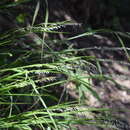fr
noms dans le fil d’Ariane


Das Mittelmeer-Perlgras (Melica minuta) ist eine Art aus Gattung der Perlgräser (Melica) und gehört zur Familie der Süßgräser.
Das Mittelmeer-Perlgras bildet lockere Rasen, seine Halme werden 10 bis 100 cm hoch und sind schlank und glatt. Die Blätter sind zusammengerollt 1 bis 4 mm breit, ausgebreitet aber bis 8 mm breit; die Blattscheiden sind kahl. Das Blatthäutchen ist bis 5 mm lang und gestutzt oder zerschlitzt. Die Rispe ist locker, 4 bis 10 cm lang und hat oft abstehende Zweige. Die Ährchen sind 5 bis 9 mm lang, zuweilen nickend und besitzen 2 fertile Blüten. Die Hüllspelzen sind eiförmig-lanzettlich, aber ungleich groß und oft braun-violett; die untere Hüllspelze ist in der oberen Hälfte häutig. Die Deckspelzen der fertilen Blüten sind neun- bis elfnervig.
Die Chromosomenzahl beträgt 2n = 18 oder 36. Das Mittelmeer-Perlgras blüht zwischen April und Juli.
Das Mittelmeer-Perlgras ist eine Art des Mittelmeergebietes; es kommt in Südeuropa, in Nordafrika und in Vorderasien vor.[1] Es wächst dort in Felsspalten, Felsfluren und lichten Wäldern.
Das Wort „minuta“ ist lateinisch und bedeutet „klein“.
Das Mittelmeer-Perlgras (Melica minuta) ist eine Art aus Gattung der Perlgräser (Melica) und gehört zur Familie der Süßgräser.
Melica minuta is a species of grass that can be found in the Mediterranean Basin, from Portugal and Morocco to the Eastern Mediterranean.[1]
The species is perennial and have 20–50 centimetres (7.9–19.7 in) long culms. Both the leaf-sheaths and the leaf-blades have glabrous surface. The other features are different though; Leaf-sheaths are tubular and are closed on one end while leaf-blades are 1–2 millimetres (0.039–0.079 in) wide and are hairy as well. The eciliated margin have a ligule that is 3.5 millimetres (0.14 in) long. The panicle is linear, open, nodding, and is 3–12 centimetres (1.2–4.7 in) long with the main branches of the panicle are spread out. They carry 7–30 fertile spikelets.[1]
Spikelets are oblong, solitary, are 7–9 millimetres (0.28–0.35 in) long and are pediceled. They also have 2 fertile florets which are diminished at the apex. The sterile florets are also present in a number of 2-3, and are barren, cuneate, and clumped. Both the upper and lower glumes are keelless, membranous, oblong and have acute apexes. Their size is different though; Lower glume is 5–7 millimetres (0.20–0.28 in) long, while the upper one is 6.5–8 millimetres (0.26–0.31 in) long.[1]
Its lemma have scaberulous surface with the fertile lemma being chartaceous, keelless, oblong, ovate and of the same size as the upper glume. Lemma have an acute apex, with palea being 2-veined. Flowers are fleshy, oblong and truncate. They also grow together, have 2 lodicules and 3 anthers. The fruits have caryopsis, are 2.5–3 millimetres (0.098–0.118 in) long with additional pericarp and linear hilum.[1]
Melica minuta is a species of grass that can be found in the Mediterranean Basin, from Portugal and Morocco to the Eastern Mediterranean.
Melica minuta é uma espécie de planta com flor pertencente à família Poaceae.
A autoridade científica da espécie é L., tendo sido publicada em Mantissa Plantarum 1: 32. 1767.[1]
Trata-se de uma espécie presente no território português, nomeadamente os seguintes táxones infraespecíficos:[2]
Melica minuta é uma espécie de planta com flor pertencente à família Poaceae.
A autoridade científica da espécie é L., tendo sido publicada em Mantissa Plantarum 1: 32. 1767.
Стебла 20–50(-80) см, прямостоячі. Листова пластинка 3–14 х 0,1–0,4 см, згорнута, рідше плоска. Волоть 5–14(-22) см, пухка. Колоски 7–10 мм, з 2 родючими квітами. Зернівки бл. 2,2×1 мм, чорнуваті, блискучі. Цвіте з квітня по липень.
Північна Африка: Алжир; Лівія; Марокко; Туніс. Західна Азія: Кіпр; Єгипет — Синай; Ізраїль; Йорданія; Ліван; Сирія; Туреччина. Південна Європа: Албанія; Хорватія; Греція [вкл. Крит]; Італія [вкл. Сардинія, Сицилія]; Македонія; Франція [вкл. Корсика]; Португалія; Іспанія [вкл. Балеарські острови, Канарські острови]. Росте в ущелинах, безплідних кам'янистих місцях і рідколіссі.
Melica minuta là một loài thực vật có hoa trong họ Hòa thảo. Loài này được L. mô tả khoa học đầu tiên năm 1767.[1]
Melica minuta là một loài thực vật có hoa trong họ Hòa thảo. Loài này được L. mô tả khoa học đầu tiên năm 1767.